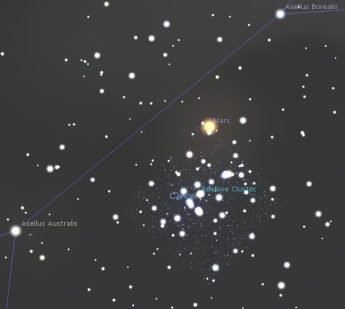This Week’s Sky at a Glance, 2025 May 3 – May 10
This Week’s Sky at a Glance, 2025 May 3 – May 10
Happy Astronomy Day! It is easy to be overwhelmed by the night sky when you are just getting into astronomy as a hobby. A good starting point which requires no equipment is to learn and pick out the constellations. Theoretically, we can see all or parts of 66 of the 88 constellations from New Brunswick. An initial goal of 50 is doable over a year, and challenging if you live in a light polluted area. Meteors require no equipment and a few appear every hour in a dark sky. Try for 25 or 50 in a year, knowing you can pad your total during several annual meteor showers, especially in mid-August and mid-December. It helps to maintain a record of your observations, including dates, times, locations, what you observed and any other details you want.
The Royal Astronomical Society of Canada (RASC) has observing lists for various levels of experience, accessible through their website (rasc.ca) under the Observing tab. There are three programs for beginners, including two for exploring features of the Moon using binoculars or a small telescope. The other is the Explore the Universe Program, which includes 110 objects in five categories: Constellations and Bright Stars, the Moon, Solar System, Deep Sky Objects, and Double Stars. By finding and recording your observations for half the objects in each category of this program you can apply for a certificate and pin. You can download the lists for the other programs but the certificates and pins are for members only.
This Week in the Solar System
Saturday’s sunrise in Moncton is at 6:02 and sunset will occur at 8:30, giving 14 hours, 28 minutes of daylight (6:09 and 8:33 in Saint John). Next Saturday the Sun will rise at 5:52 and set at 8:39, giving 14 hours, 47 minutes of daylight (6:00 and 8:41 in Saint John).
The Moon rides above Mars this Saturday evening to highlight Astronomy Day, and it is at first quarter on Sunday with the Lunar X being visible around 9 pm. The Moon is near Regulus on Monday and Spica on Friday. Mars is within a binocular view of the Beehive star cluster all week, passing through the upper portion over the first few evenings. Jupiter is still in good position for twilight observing between the horns of Taurus, setting around 11:30 midweek. Saturn is within a wide binocular view of bright Venus in early morning all week, while Mercury is lost in the twilight glow. The Eta Aquariid meteor shower peaks this Tuesday morning, with the radiant rising in the east around 3 am.
The Saint John Astronomy Club meets in the Rockwood Park Interpretation Centre this Saturday at 7 pm. Tune in to the Sunday Night Astronomy Show at 8 pm on the YouTube channel and Facebook page of Astronomy by the Bay.

